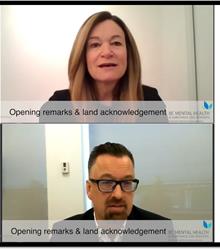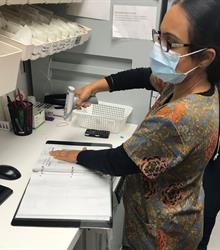One example of our team leveraging technology to advance knowledge was the inaugural B.C. Concurrent Disorders Conference, which took place in March 2021. Initially meant to be an in-person conference for mental health and addictions professionals, the event went fully online in response to pandemic restrictions. All planning was done virtually, and the event itself was hosted via Zoom.
 Moving the conference online proved to be a catalyst — it attracted more attendees than organizers ever imagined, with over 1,200 registered attendees and speakers from across B.C., Canada, the U.S. and Australia.
Moving the conference online proved to be a catalyst — it attracted more attendees than organizers ever imagined, with over 1,200 registered attendees and speakers from across B.C., Canada, the U.S. and Australia.
“Having this event online ended up working to our advantage,” said Dr. Vijay Seethapathy, the chief medical officer of BC Mental Health and Substance Use Services. “During the event, we heard from participants that many wouldn’t have been able to attend a full-day, in-person conference because of their geographical location or work commitments.
Technology meant we were able to open the event up to more people than expected and advance knowledge among a larger group of health care professionals. There were many teams involved in making the conference a success — virtual health, communications, learning and development and IT. They are the ones that ensured things ran smoothly.”
As the appetite for more online education and engagement grows, the Learning and Development team has also pivoted. As always, they’re dedicated to building capacity so that staff and physicians can provide better care — and they’ve adopted new ways of engaging.
“Over the last year, we’ve had to immerse ourselves deeply into various technologies,” says Helen Lingham, the director of Learning and Development. “So much of our education used to be classroom-based. When the pandemic hit, we had to quickly figure out how to shift to being completely virtual. That meant becoming much more literate than the average person in the technologies we use.”
One of the most widely used tools for education and training within the program is LearningHub, a database that houses courses, webinars and presentations on everything from onboarding to the latest evidence-based therapies and treatments. LearningHub and other e-learning tools are popular education vehicles, especially until we can gather in classrooms again. Finding ways to make e-learning more exciting is a priority for the Learning and Development team.
“We’re constantly looking for new, engaging ways for people to learn online,” says Helen. “Right now, we’re exploring gamification, and that’s really exciting. The idea is that for mandatory training, like, for instance, therapeutic and relational security, we can build in prizes or competitive elements to the lesson or course design to make it more enjoyable. We want people to come back time and again so they can continue building their knowledge and skills.”
Another tool that has been successfully adopted is ThoughtExchange, which BC Mental Health and Substance Use Services started using in April 2020. This discussion and engagement tool enables meaningful interaction and allows for ideas and feedback to be gathered in real time. People can share their own thoughts, and also see and engage with others’ ideas, voting the most popular or common responses to the top. This discussion and engagement helps with analysis.
"It helps bridge that gap in engagement that we’re all feeling these days."
“ThoughtExchange has been incredibly useful,” says Helen. “It can be a brainstorming tool, a planning tool, even an evaluation tool when we look for ways to improve our sessions, systems or processes. The great thing about ThoughtExchange is how quickly it works. We can run them before, during, or after meetings or events, and it takes less than five minutes. Extracting this sort of data in this way is far quicker with this tool than over email, surveys or in person. It helps bridge that gap in engagement that we’re all feeling these days.”
An important use of technology in health care is timely documentation and documentation integrity — making sure that client medical records and all other pertinent information are easily accessible, up to date, accurate and secure.
BC Mental Health and Substance Use Services recently implemented an electronic health record called CST Cerner at two of its sites — the Burnaby Centre for Mental Health and Addiction, and Heartwood Centre for Women. CST stands for clinical systems transformation.
CST helps care providers bring efficiencies to their work. In just a matter of moments, a physician can have a full picture of the client’s medical history. The technology also improves accuracy — care providers aren’t relying on a client to remember their entire medical history, including important details about medications and diagnoses.
The technology also helps to protect patients’ dignity and means a less stressful experience for clients. Most mental health and substance use clients have experienced trauma in their lives, and having to relive these experiences when sharing their history with a health care provider can be stressful and difficult. Now, thanks to CST, they no longer have to do this.
 Implementation of CST Cerner also required integration of new devices into daily care such as microphones, barcode scanners, and workstation-on-wheels (WOW). Some WOWs act as medical carts that have built-in computers, medication compartments and barcode scanners. Devices with attached microphones allow physicians to efficiently conduct and document consultations using speech recognition software.
Implementation of CST Cerner also required integration of new devices into daily care such as microphones, barcode scanners, and workstation-on-wheels (WOW). Some WOWs act as medical carts that have built-in computers, medication compartments and barcode scanners. Devices with attached microphones allow physicians to efficiently conduct and document consultations using speech recognition software.
Use of barcode scanners by nursing staff allows accurate identification by scanning a client’s photo I.D. and ensures the right client receives the right medication and dose at the right time. This information integrates with the client’s individual electronic medication administration record (MAR). The scanning also reduces human error in medication administration, showing an alert if the wrong person, or medication is scanned.
Additionally, new voice-to-text technology means written charts and illegible handwriting are a thing of the past. Speech recognition is a technology connected with CST that enables doctors to add notes and diagnostic information to a patient’s online history by speaking into a microphone. This is a far quicker way for doctors to see patients and provide them the care they need.
“These changes truly are clinical and systems transformations,” says Prabhjot Gill, the director of quality, safety and clinical informatics. “Thanks to these technologies, there is more security, safety, and efficiency in client care as teams can now enter and access data from anywhere at any time, including sharing clients’ charts between members of the care team. Things run smoother for the care providers and the patient and we’re seeing great success at all of our sites.”
